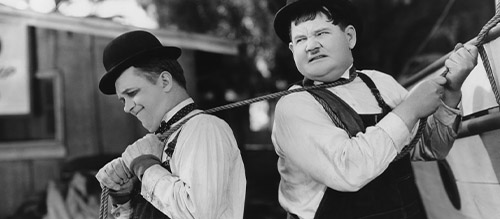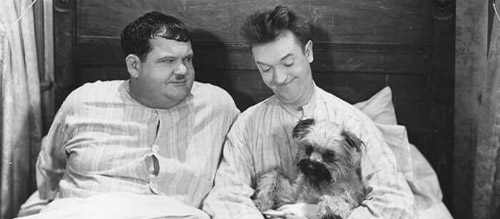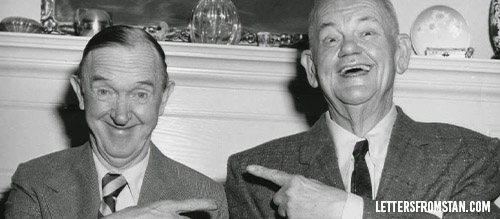The Enduring Legacy of Stan and Ollie
It is hard to sum up why Laurel & Hardy have remained so beloved when compared to their Hollywood contemporaries. Even in their prime, the comedy duo had little of Charlie Chaplin’s political drive or sentimentality; they weren’t great stuntmen like Buster Keaton, nor did they share his intellectual prowess; they didn’t satirise blockbusters like Abbott & Costello, who often secured the likes of Bela Lugosi, Boris Karloff, and Lon Chaney Jr. into their casts. They weren’t even incredible dancers.
Nevertheless, a century removed from their first Hollywood appearance, Stan Laurel and Oliver Hardy continue to be celebrated both on-screen and off. Not only do audiences love their movies, they adore the men themselves. This all-encompassing fandom highlights the pair’s magic ingredient, one so rare in the performing arts: transparency. The two men allowed themselves to be known by all, inside and out, and their movies serve as an extension to this transparency, rather than a buffer between artist and audience. Laurel & Hardy’s exaggerated capers don’t lie, but rather blur the lines between cinema and real-life, indicating a genuine humanity behind the clowning. After all, Laurel & Hardy always played themselves.
Whatever occupation that writer Stan Laurel conjured up for the pair – whether down-and-outs, foreign legion soldiers, wealthy socialites, or students at Oxford – they rarely felt the need to alter their looks, mannerisms, or even their names. Their performances were true to life, capitalising on many facets of their real-life personalities.
Performer Jackie Gleason noted that Oliver Hardy “[…] was a delight to watch drinking, because he was just like his character. He’d wipe a drop off the glass, pick it up with his pinkie way out, sip it, put it down, tap it, very much like the character that he played”.
The pair never broke character, even when breaking the fourth wall, which often consisted of Ollie impatiently glaring at the camera as absurdity unfolded around him.
Such mannerisms, from which much of their humour was derived, were reinforced at every possible comedic opportunity. If Hardy could sternly push Laurel to one side in order to enter a building first, he would. If ever there was the opportunity for Laurel to remove his hat and ruffle his hair, whether out of confusion, satisfaction, or just plain boredom, that iconic bowler would be off in a flash. Their contrasting body types also played further into their characters, with Hardy always celebrating his weight by finding comedy in it, despite the many health problems he would later experience.
Outside of their films and stage-shows, the pair always dutifully played up to their roles, such as when they attended the birthday party of an obscure British Railway station. Footage shows Hardy snatching a comically oversized key from Laurel, before making an idiot out of himself by attempting to unlock a door which Laurel then opens with ease. It’s possible to hear the crowds roaring with laughter as the pair bring fiction into reality – or, more accurately, highlight how true to life their movies were.
Oliver Hardy portrayed himself as a pompous bully with a delicate ego. He knows less than what he thinks he does, and can be exceptionally lazy and decadent, even when dire circumstances demand otherwise. Stan Laurel was the humble underdog, clumsy and scatter-brained. Despite the two men being affable and intelligent behind the curtain, these less desirable aspects had more than a grain of truth to them. Hardy could indeed act entitled, clocking off at 5 to hobnob with stars like Bing Crosby, whilst Laurel was a humble workaholic with a thousand ideas.
This dynamic was complementary, but inevitably led to fall-outs. As depicted in the 2018 biopic Stan & Ollie, the pair’s behind-the-scenes arguments often trumped their on-screen squabbles. Such heavy topics as contracts, careers, relationships, and personal health, dominated many of their disagreements. These off-screen issues shine through in their movies; of all the double-acts that ever graced the silver screen, Laurel & Hardy truly knew how to argue.
Alongside their reputation for honest, no-frills comedy was another development which helped the pair to achieve success: talkies. Many of Laurel & Hardy’s silent contemporaries suffered during the shift to sound, a theme explored as recently as 2011 in the French comedy-drama The Artist. Charlie Chaplin, for example, had a voice that audiences did not feel suited his image. Although sound allowed him to expound on the morals of man, such as in his satire of Hitler in The Great Dictator (1940), for many Chaplin exuded more charm when mute.
Stan & Ollie, on the other hand, had their career skyrocket when sound film became popular in the late 1920s. The pair’s voices suited their characters perfectly; Stan’s croaky British twang highlighted his innocence, whilst Ollie’s Southern accent matched his bossy aggression down to a tee. In a way, the fact that the duo never pretended to be anyone else meant that any addition to their characters would seem fitting, provided it was honest.
Sound also allowed Oliver Hardy to show off his excellent singing voice, something which only his music-hall audiences would have so far appreciated. “Blue Ridge Mountains”, a duet with Stan in their iconic Western Way Out West (1937), reeks of class, one of those rare moments where two comics can do something with such sincerity that even the odd gag doesn’t detract from its effect. They sing a heartfelt song in beautiful harmony, and one doesn’t know whether to laugh or cry. Few comedy acts can elicit such a response, but Laurel & Hardy’s films have many such instances.
What talkies really spotlighted was Laurel’s excellent writing ability. Verbal gags had occurred in their silent films in the form of title cards, but the spontaneity of sound added to their liveliness and frequency. The Live Ghost (1934) sees Laurel refusing to join a ship’s crew due to the ocean being “infatuated with sharks”. Hardy’s overconfident idiocy is summed up in his correcting of Laurel: “he means infuriated with sharks!”. Talkies paved the way for catchphrases, too, such as Hardy’s furious “Why don’t you do something to help me?!” and Laurel’s crumple-faced cry to the camera.
But whilst sound was elevating these on-screen arguments to a wittier and more bitter intensity, every new film added to the canon of an inexplicably close friendship. Of such bickering double-acts it’s often asked, “how are these two still friends?”, and Laurel & Hardy’s characters are no exception, remaining inseparable throughout their 107 films together despite their blatant differences and violent disagreements. Yet the seeds of believability are always being sown; the impromptu duets, the shared laughter at others’ expense, the unashamed bed-sharing in Laughing Gravy (1930) – these all betray, in the most warm and adorable way possible, a very real friendship.
This dichotomy feels believable because it’s real; much like the arguments, this heart-warming inseparability was merely a reflection of the two men’s reality. Just like their on-screen counterparts, the real Laurel & Hardy would remain best friends until the very end. Even after Hardy’s death in 1957, their legacy was so cemented for Laurel that he refused to perform again without his partner of 30 years.
The pair’s fondness for each other was more than evident when seen in the things they had to say about one another.
Stan said, of Ollie:
“Hardy inspires me. He is like the character he portrays because of certain individual traits. To me, he is refreshing, so darned human! His humour lies in the funny way he thinks. I can look at him and know just what he is thinking. His moods are very funny to me, the moods of a born comedian.”
And Ollie, of Stan:
“Laurel is the most unselfish man that ever lived and the funniest man in the world, as a comedian, as a writer and as a human being. He is so distinctive that he stands absolutely alone. He doesn’t depend upon funny clothes to make him funny, he is funny in himself. And I have sense enough to stand back and let him be funny.”
Laurel & Hardy didn’t reserve their love for one another. They were famously gracious to their followers, and infinitely grateful to those who continued to attend their live shows after their movie careers had begun to dwindle.
In his later years, Stan Laurel had his phone number listed in the LA directory, happily chatting to those die-hard fans brave enough to call. Funnily enough, his home number had been revealed decades previous in their hilarious short Blotto (1930), where Stan would recits to the telephone operator: “Oxford, oh, six, one, four!”.
Even the author feels the echoes of Stan & Ollie’s warmth in the form of a photo autographed for his mother, who was too ill to attend their 1954 performance at the Birmingham Hippodrome. Throughout the world there will be similar mementos of their loyalty, with many fond memories to accompany them.
In 1951 the pair released their last ever feature film, Atoll K. Poor reviews reflected a decline in their career, and many audiences were saddened at how old and ill the two gentlemen looked. They were both heavy smokers, and Oliver Hardy would suffer a heart attack three years on, and die three years after that from a series of strokes. His partner Stan would join him eight years later, at the age of 74. Stan’s funeral was attended by countless admirers including fellow star Buster Keaton, who stated, “Chaplin wasn’t the funniest. I wasn’t the funniest. Stan Laurel was the funniest.”
With their comedy, Laurel & Hardy tapped into something immortal. Their legacy will no doubt live on for as long as people will want to laugh. They emerged as cinema was taking over the world and set many precedents; it may mostly have been two men in ill-fitting suits fighting over incomplete tasks, but that only serves to highlight how childish true comedy is, and how primitive the act of enjoying it.
Still today, audiences can sense that the two men were enjoying themselves immensely. Once they’d met their lifetime comedy partners, Stan & Ollie insisted on having fun up until the very end. They didn’t look down on audiences; on the contrary, they allowed audiences to look down upon them, never taking themselves more seriously than was necessary. Laurel & Hardy made fools out of themselves for others and, despite their fame and wealth, didn’t lose sight of what was most important; beneath it all, being human.
Written by Louis B Scheuer
You can support Louis B Scheuer in the following places:
Twitter – @louisbscheuer
Instagram – @louisbscheuer






Mr. Scheuer makes one grievous error in his essay on Stan Laurel and Oliver Hardy: That is to perpetuate the absolute MYTH that the men didn’t get along on occasion. Commenting on Ollie’s 9 to 5 schedule compared to workaholic Stan, Mr. Scheuer stated “This dynamic was complementary, but inevitably led to fall-outs. As depicted in the 2018 biopic Stan & Ollie, the pair’s behind-the-scenes arguments often trumped their on-screen squabbles.” That story line was pure fabrication — the writer’s creative license to add some drama to the film.
Of the hundreds of associates who worked with Stan Laurel and Oliver “Babe” Hardy and have been interviewed for books and documentaries, NOT ONE has even hinted that the duo had any animosity toward or argument with the other! It is unfortunate that an otherwise excellent film like 2018’s STAN & OLLIE has helped to perpetuate the fiction of Laurel and Hardy’s not getting along. The Sons of the Desert, the international club devoted to the memory of Stan and Ollie, continues to work to preserve facts about the beloved team. Certainly they had their moments of disagreement, but these were private affairs and unwitnessed by others.
The 2018 biopic also wrongfully depicts Stan and studio boss Hal Roach having a public argument about money. Stan and Roach always conducted their business behind closed doors and rarely over money — STORY was Roach’s greatest concern, and usually left that funny business to Stan.
The biopic does get a few other things wrong (UK tour promoter Bernard Delfont was a genuinely fine fellow and not the smarmy character depicted in the film, the feature combines three separate UK tours into one, rearranges the facts, and shows initially small audience attendance, among other minor errors), but for the most part, STAN & OLLIE celebrates the boys in a loving way just as the Sons of the Desert do. Perpetuating blatantly wrong information when the truth is so obvious with a little research is something we SOD members abhore.
A well written, informative peice with an obvious love for the subject matter!
Long live Stan & Ollie, true comedians and an inspiration.